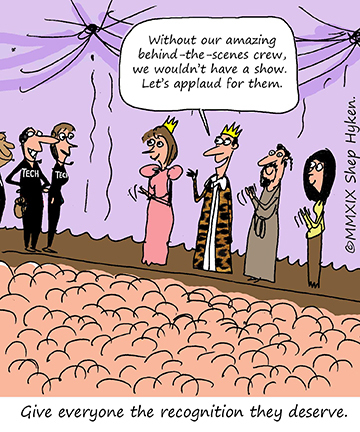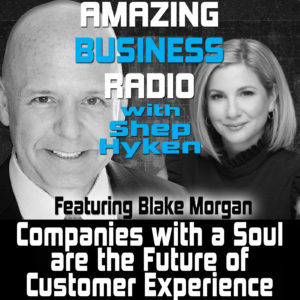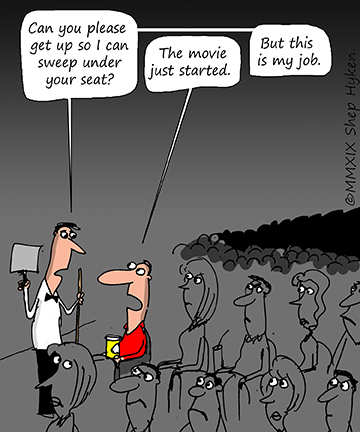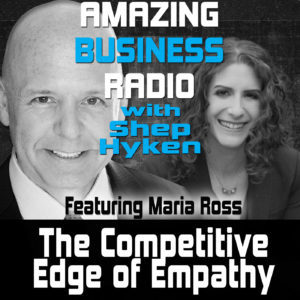Shep Hyken's Blog, page 117
October 30, 2019
Give Recognition Where It’s Due
 There are some pretty important people in your organization, and I bet many of them don’t know just how important they are. Most likely, they aren’t getting the recognition they deserve.
There are some pretty important people in your organization, and I bet many of them don’t know just how important they are. Most likely, they aren’t getting the recognition they deserve.
I was talking about this concept with my friend, Kent Higginbotham, and he shared a perfect example of this. Kent was in the Navy, and we affectionally nicknamed him “Admiral.” While in the Navy, Kent flew helicopters. Kent mentioned that most people think the pilot and co-pilot are the most important jobs on a helicopter. No doubt, without these two—or at least one of them—the helicopter can’t take off and land. However, Kent had a different perspective. To him, the most important person was the mechanic who made sure the helicopter was safe to fly. His words were, “That guy never got the credit he deserved.”
Not long ago I wrote about the famous chef, Thomas Keller. His first job at a restaurant was washing dishes. While it was probably the lowest-paying job in the restaurant, it wasn’t long before he realized it was one of the most important. No matter how famous the chef is—or how good the food is—if a meal goes out to a guest on a dirty plate, it’s getting sent back. Without clean dishes, you can’t serve the food.
In the corporate world, the job of a receptionist may not be the highest-paying in the company—most likely, far from it. However, the receptionist answers the phone, and the way they do it sets the tone for the rest of the interaction the customer may have with others in the company. Some companies have bestowed the title “Director of First Impressions” upon the receptionist, giving their responsibility the recognition that it deserves.
If the receptionist gets the title “Director of First Impressions,” maybe the dishwasher should have the title, “Manager of Cleanliness,” and the Navy’s helicopter mechanic should have the title, “Chief of Keeping the Team Alive.” You get the idea. Everyone deserves a title that reflects their true role in the organization—and recognizes how important they are.
Think of the different jobs everyone has where they work. What are their most important responsibilities? It doesn’t matter if it’s the lowest- or highest-paying job. Everyone has something they do that is crucial to the organization—something that would be noticed if that person were not there. Once you know what yours is, excel in it. Be the best you can be at it. And, above all, give everyone the recognition they deserve for their unique and important role within your company.
Shep Hyken is a customer service expert, keynote speaker, and New York Times bestselling business author. For information, contact 314-692-2200 or www.hyken.com. For information on The Customer Focus customer service training programs, go to www.thecustomerfocus.com. Follow on Twitter: @Hyken
customer service training programs, go to www.thecustomerfocus.com. Follow on Twitter: @Hyken
(Copyright © MMXIX, Shep Hyken)
The post Give Recognition Where It’s Due appeared first on Shep Hyken.
October 29, 2019
Amazing Business Radio: Blake Morgan
 Companies with a Soul are the Future of Customer Experience
Companies with a Soul are the Future of Customer Experience
Understanding Companies and Customers of the Future
Shep Hyken interviews Blake Morgan. They discuss her new book, The Customer of the Future: 10 Guiding Principles for Winning Tomorrow’s Business, focusing on the psychological, technical, and experiential components of building a good customer experience.








The Interview with Blake Morgan:
If you don’t get the simple stuff down, you will lose customers. The “basics” include knowledge of your customers and their wants and needs. Above all, seek to make their lives easier rather than more difficult.
Psychological components of CX are the invisible pieces of your strategy. These include a CX mindset, company culture, and leadership development.
Everyone in a company, from executives to frontline employees, must have a CX mindset—an attitude of service and a desire to make their customers’ lives better.
There is a correlation between how employees feel at work and the quality of work that they do. Studies show that companies that invest in the employee experience are 4.2 times more profitable than companies that don’t.
Don’t leave training up to chance; it must be intentional and consistent. Leaders must understand company culture and what happens at every level of the organization. One person cannot turn a company around alone.
There is often a disconnect between technology and human connection. It’s rarely technology that is missing from a company; it’s a human connection and a service mindset.
On an experiential level, design a friction-free customer experience, consider customer-focused marketing, and, above all, design and commit to a code of ethics. This is especially important in today’s fast-paced world of technology and AI.
The most important thing when thinking about the customer experience is simply to make others’ lives easier and better. This extends beyond customers to employees as well. In the end, the companies who “have a soul” in this way will be the ones that succeed.
Quotes:
“The company of the future is the company with a soul. It’s the company that does the human thing for both its customers and its employees.” – Blake Morgan
“Life is hard. Life is stressful. If we can reduce stress for our customers, that’s the ultimate goal—making people’s lives easier and better so they can do what they want to do.” – Blake Morgan
“Technology isn’t what’s missing. It’s the service mindset and the human connection.” – Blake Morgan
“Don’t make life harder on your customers to make it easier on your business.” – Blake Morgan
About:
Blake Morgan is a keynote speaker, customer experience futurist, and author of two customer experience books. Her latest is The Customer of the Future: 10 Guiding Principles for Winning Tomorrow’s Business.
Shep Hyken is a customer service and experience expert, New York Times bestselling author, award-winning keynote speaker, and your host of Amazing Business Radio.
This episode of Amazing Business Radio with Shep Hyken answers the following questions … and more:
How can I improve my CX?
How can I prepare for the future of CX?
How can I build a good employee experience?
How can I build a good company culture?
What is the balance between technology and the human experience?
The post Amazing Business Radio: Blake Morgan appeared first on Shep Hyken.
October 28, 2019
5 Top Customer Service Articles for the Week of October 28, 2019
Each week I read a number of customer service and customer experience articles from various resources. Here are my top five picks from last week. I have added my comment about each article and would like to hear what you think too.
How To Build A Customer Service Strategy And Drive Repeat Business by Krishna Charan
(Freshdesk) Building an airtight customer service strategy is the best way to weather the demands of today’s savvy customers. We’d like to help you build a viable customer service strategy with nine actionable customer service ideas that can be a huge differentiator for your business.
My Comment: Let’s start this week’s Top Five Roundup with a list of nine “actionable ideas” to help drive repeat business. What I like about how this article is written is that it lists the nine ideas at the beginning of the article. If one of them resonates with you, just click on it and you will be taken to the idea.
Bring Customer Loyalty Under the Customer Experience Umbrella by Phil Britt
(CMSWire) Forrester’s 2019 CX Index found that most loyalty programs are ineffective. This, at a time as the company notes, when “it costs 500% more to acquire a new customer than to retain a current one.”
My Comment: The title of the article intrigued me. Frankly, I’m surprised that loyalty, service and experience are separate. For that matter, let’s toss in marketing – because, isn’t all of this marketing?
Four Brands Getting Customer Experience Right by Ryan Hollenbeck
(Chief Marketer) Understanding customer needs and desires across their journey and ensuring organizations can respond accordingly has never been more important.
My Comment: My favorite way to learn is through example or story. Here are four examples from four brands on how they are delivering a great customer service experience. While you may have heard of these brands, they aren’t the typical ones that are showcased for great service.
The 6 Customer Experience (CX) Trends Every Company Must Get Ready For Now by Bernard Marr
(Forbes) In order to become and remain competitive, companies need to tap into the latest technologies and customer experience trends. Here are 6 customer experience trends every company must get ready for.
My Comment: While the article implies that these six customer experience trends are for every company, I can’t agree. But, what I can tell you is that there are at least three or four (and for some, all six) that any company, in any type of industry (B2B or B2C), could consider. I look forward to the future!
Super-charge the Journey to Customer-Centric Culture. by Wayne Simmons
(CustomerThink) Fast-forward 65 years, with the basis of business now shifted to customer experience, many organizations are now rediscovering Drucker’s basic idea by taking steps to become more customer-centric, and ultimately customer-obsessed.
My Comment: The author of this article is the former head of Global Service Delivery at Ritz-Carlton. And, anytime I can learn from an executive of a world-class brand, I pay attention. He even quotes from the new book by co-founder and first president of Ritz-Carlton, Horst Schulze. Good information for every organization.
 Shep Hyken is a customer service expert, professional speaker and New York Times bestselling business author. For information on The Customer Focus
Shep Hyken is a customer service expert, professional speaker and New York Times bestselling business author. For information on The Customer Focus customer service training programs go to www.TheCustomerFocus.com. Follow on Twitter: @Hyken
customer service training programs go to www.TheCustomerFocus.com. Follow on Twitter: @Hyken
The post 5 Top Customer Service Articles for the Week of October 28, 2019 appeared first on Shep Hyken.
October 25, 2019
Guest Blog: Hiring and Leadership to Improve CX in Your Call Center
This week we feature an article by Matthew Smollen who says ensuring your clients have an amazing call center experience when interacting with your brand is one of the best ways to encourage repeat and referral business.
Ensuring your clients have an amazing experience when interacting with your brand is one of the best ways to encourage repeat and referral business. This is multiplied in a contact center as often the customer experience is the main focus.
Now more than ever companies are opening more and larger contact centers and with them all focusing on CX that means more competition for you. It doesn’t matter if it’s a first-time caller or a long term client. You need to deliver memorable and high-quality interactions throughout the entirety of the customer journey.
You need to make sure that two major factors are strong. Who you hire, then how you lead them. Be picky, find the best and then once you have them, give them a reason to achieve that potential you have identified.
So how can we do it? Let’s build it from the ground up.
Recruitment
You aren’t going to be the one on the phone. All the scripts in the world won’t mean anything if the person delivering them doesn’t fit. Your agents need to love coming to work, they need to be motivated by results (the right results), and they need to care about the client. So what should we look for in a new hire?
Use behavioral interviewing. At some point, your agents are going to have to deal with emotional calls, if they are unable to deal with them they will escalate far more calls then they need to, using more of the supervisor’s time. Start some questions with “tell me about a time that you…” the idea is to prompt your candidate to talk about their successes and failures and get a gauge on how empathic they are.
Record your interview. Your agent will be the first point of contact, they need to sound approachable and capable. Listen back on their natural speech and also have them read off a script. A speaking voice may be the difference between candidates.
Target Posting. Make sure that you are displaying the opportunity to the right people. Is there an area or interest-specific group/board to be advertising on? Use effective analytics to maximize your exposure to the best potential candidates.
Leadership
So now we have the right people. What do we do with them? How can you and your leaders help your agents feel happy and motivated?
Make sure the environment is positive and encourages growth. That way people will want to come to work and try their best every day. Training means your agents will perform better and feel like their job is making them a more complete person.
Make sure to join the troops on the front line occasionally. Julius Caesar himself would never back away from the fight, placing yourself in different areas of the call center can show your team that you know and understand the work they do.
Support your agents with the best technology and industry practices. If you want the best results you need to be working in the most productive way. The best call centers aren’t just pumping out calls from a call sheet with a desk phone. Make sure you are positioning yourself for success!
If you push every day to be sure that your agents see the best of you, you will see better out of them. Following some simple steps to have the best people lead by the best people will mean your agents are energized and positive all day. Your clients will feel that buzz, it’s electrifying and contagious. They will remember you.
Matthew Smollen is North American Sales Manager at Integra Contact Center Solutions he is also a CX and Contact Center expert with 12 years of experience in the industry.
For more articles from Shep Hyken and his guest contributors go to customerserviceblog.com.

Read Shep’s latest Forbes article: Customer Loyalty And Retention Are In Decline
The post Guest Blog: Hiring and Leadership to Improve CX in Your Call Center appeared first on Shep Hyken.
October 23, 2019
Bad Timing or Bad Decision
 Recently, my wife and I went out to dinner. We planned to go to a movie afterward but couldn’t decide what to see. Easy solution—we decided to go home and watch one of our favorite shows on Netflix. We arrived home, got comfortable, turned on the TV and… nothing. The TV went on, but there was no cable or Internet signal. There was an outage. Obviously, the cable company didn’t do this on purpose. It was out of their control. Sometimes things happen. It was just bad timing.
Recently, my wife and I went out to dinner. We planned to go to a movie afterward but couldn’t decide what to see. Easy solution—we decided to go home and watch one of our favorite shows on Netflix. We arrived home, got comfortable, turned on the TV and… nothing. The TV went on, but there was no cable or Internet signal. There was an outage. Obviously, the cable company didn’t do this on purpose. It was out of their control. Sometimes things happen. It was just bad timing.
A couple of weeks later, I attended a conference at a hotel in Orlando. We enjoyed the speakers in the morning session, and after about two hours, it was time for a break. More than 600 of us got up to stretch our legs and, as most might do after a morning session preceded with coffee, head to the restroom.
I immediately noticed a problem. The restroom outside of our meeting room was “closed for cleaning.” The hotel staff was cleaning the restroom at 10 in the morning, right in the middle of our break. Once again, it was just bad timing.
Or was it?
Just like the cable company, the hotel staff didn’t do this on purpose. The difference was that this was in their control. They could have cleaned the bathrooms at a different time, perhaps before the meeting even started—or maybe in the middle of the night when there was no one around.
On that day, I was with my friend Dennis Snow, a fellow customer service expert who spent 20 years working at Disney. I could read his mind. He was thinking the same thing I was. He said, “They should have a better sense of when to do this.”
He went on to say that it drives him crazy when he arrives at a hotel in the middle of the afternoon to check-in and the cleaning team is vacuuming the carpets in the lobby. There’s nothing quiet about those industrial-strength vacuum cleaners. One would think the hotel staff would have the sense to find a less busy time to do their noisy maintenance or cleaning.
Here’s my point. It’s bad timing if it’s an unexpected accident that causes an inconvenience. It’s not bad timing when someone has control over a situation. That’s a bad decision. The hotel should have been smarter about when to clean the restrooms. How could they not realize there was a meeting with 600 people who would need to use the facilities?
Bad timing isn’t really bad timing if you have control of the situation. Think of the things you and others around you in your organization have control over that might cause a problem or inconvenience for someone else. You may not have power over everything, but you do have the power to make good decisions. Know the difference between bad timing and bad decisions.
Shep Hyken is a customer service expert, keynote speaker, and New York Times bestselling business author. For information, contact 314-692-2200 or www.hyken.com. For information on The Customer Focus customer service training programs, go to www.thecustomerfocus.com. Follow on Twitter: @Hyken
customer service training programs, go to www.thecustomerfocus.com. Follow on Twitter: @Hyken
(Copyright © MMXIX, Shep Hyken)
The post Bad Timing or Bad Decision appeared first on Shep Hyken.
October 22, 2019
Amazing Business Radio: Maria Ross
 The Competitive Edge of Sympathy
The Competitive Edge of Sympathy
Creating a Culture of Empathy to Drive Success in Business
Shep Hyken interviews Maria Ross. They discuss her new book, The Empathy Edge: Harnessing the Value of Compassion as an Engine for Success, why empathy creates a competitive advantage in business, and how companies can foster empathy from the inside out.








The Interview with Maria Ross:
Authentic empathy can create a competitive advantage for companies and can reap huge rewards and bottom-line benefits. In an empathetic culture, employees are more innovative and productive, while customers are more loyal and result in more revenue and good press.
Empathy must be authentic for it to be effective. Avoid the “empathy veneer,” which is the mere illusion of empathy without the reality of it. Companies cannot pretend to be empathetic to reap the rewards that true empathy provides—if they try, it will backfire spectacularly.
For empathy to be believable on the outside, it must start and be built from the inside out—just like a good brand. This means hiring the right people, training them correctly and continually, rewarding them appropriately, and creating and preserving an internal culture that fosters empathy.
Set up internal processes and structures that support the culture of empathy you want to build and preserve. This includes rewards structures—appropriately incentivize the action and behavior that reflects the culture you’re trying to foster. You get the culture you endorse and reward.
Empathy can start now, and it can start with one individual. It won’t happen overnight, but rather through small steps that will result in big change.
There are five ways leaders and teams can take action now to create empathy:
Practice presence. You can’t be empathetic if you’re not present.
Listen more; stay humble. Focus on what you hear without being prescriptive.
Be curious. The most empathetic people are the ones who ask questions, especially why.
Cultivate confidence. You cannot be empathetic toward others if you are not empathetic toward yourself.
Create an environment of trust. You cannot have an empathetic workplace if everyone is living in fear.
It’s important to facilitate intergenerational understanding. Millennials and Gen Z’ers are some of the most diverse and empathetic people in the workforce. Differences between generations can cause friction and reduce productivity. Embrace communication and work to understand others’ experiences.
Quotes:
“Empathy must start from the inside out, just like a good brand, if it’s to be believable and genuine.” – Maria Ross
“Always start with questions when you’re met with negative behavior in the workplace. Instead of reacting, ask why.” – Maria Ross
“You get the culture you endorse and reward.” – Maria Ross
About:
Maria Ross is a brand strategist, speaker, and founder of brand consultancy Red Slice. She has authored multiple books, including her latest book, The Empathy Edge: Harnessing the Value of Compassion as an Engine for Success.
Shep Hyken is a customer service and experience expert, New York Times bestselling author, award-winning keynote speaker, and your host of Amazing Business Radio.
This episode of Amazing Business Radio with Shep Hyken answers the following questions … and more:
What is empathy in business?
How do I create a culture of empathy?
How do I increase productivity?
How do I create a company culture?
How can empathy give me a competitive advantage?
The post Amazing Business Radio: Maria Ross appeared first on Shep Hyken.
October 21, 2019
5 Top Customer Service Articles for the Week of October 21, 2019
Each week I read a number of customer service and customer experience articles from various resources. Here are my top five picks from last week. I have added my comment about each article and would like to hear what you think too.
Advanced B2B CX Strategies Nobody Talks About by CustomerGauge
(CustomerGauge) In our latest eBook, we asked some of the top CX experts and influencers to discuss how B2B companies they’ve worked with have revolutionized their customer experience.
My Comment: Let’s kick off this week’s Top Five roundup with an eBook that was just released. CustomerGauge asked five customer experience experts (myself included) to address issues that B2B companies and leaders have in creating a strong and successful CX program. You’ll have to give them your name, email address and some other basic information to get the eBook, but don’t let that stop you. It’s a great publication with some important and powerful ideas.
Why Focus On Customer Experience? Here’s Why. by Jon Picoult
(Forbes) Here’s the little secret that business leaders don’t like to discuss: many of them aren’t sold on the idea that a great customer experience actually pays off.
My Comment: I’m always intrigued when I see the stats about how customer-focused companies outperform those that aren’t. This article has one of my favorite stats, which is how companies focused on CX not only substantially outperformed the market, but also outperform CX laggards by almost three times!
Top 6 Customer Experience (CX) Strategy Tips for 2020 by Raj Roy
(MarTech Advisor) In this article, we explain why a CX strategy is critical to accelerate the achievement of your business goals, with the top 6 customer experience strategy tips to prepare you for 2020!
My Comment: As we head toward the end of the year there will plenty of experts (myself included) sharing their predictions and trends for customer service and CX for the upcoming year. If there was a race to be the first to create the 2020 list, then Raj Roy would be the winner. Here are six good strategies worthy of your consideration.
Customer Success — A Unifying Mission for CRM and CXM by Bob Thompson
(CustomerThink) In this article, I’ll discuss how the “customer success” movement has developed, what it means, and why I believe it should be a unifying mission to help companies get value from both CRM and CXM, or whatever term you want to use for being customer-centric.
My Comment: There is a lot of important information here about Customer Success (CS). I’m surprised that more companies aren’t taking a closer look at this powerful strategy. It should be baked into the customer experience. The author quotes the CEO of Gainsight’s Nick Mehta’s definition of CS: “The combination of getting customer outcomes with the experiences they want.” In other words, help them be more successful with your product. If you haven’t thought about CS (and even if you have), you should read this article.
How to Use Personalized Email to Build Emotional Intimacy with Your Brand by James Glover
(Retail Customer Experience) Which single metric correlates most strongly with a brand’s retail success? You might be surprised to learn it’s not click-through rate (CTR), or segmentation precision, or even the seamlessness of the customer journey — instead, it’s a more elusive factor that’s interrelated with all the above.
My Comment: The main focus of this article is on building emotional intimacy with your customers – and email just happens to be one way to do it. (Note: Email is not dead!) There are a number of recognizable (huge) brands mentioned that have done an excellent job of creating emotional intimacy. You may wonder, how can brands like Amazon and Target creating intimacy? Well, they do. And so can you by focusing on “Moments of Meaning.”
BONUS VIDEO
Customer Service Calls In Real Life by Tripp and Tyler and VERINT
This video is a … MUST WATCH! I promise you it will make you smile – if not laugh-out-loud. We can all relate to this humorous example of a customer trying to get his TV to work.
 Shep Hyken is a customer service expert, professional speaker and New York Times bestselling business author. For information on The Customer Focus
Shep Hyken is a customer service expert, professional speaker and New York Times bestselling business author. For information on The Customer Focus customer service training programs go to www.TheCustomerFocus.com. Follow on Twitter: @Hyken
customer service training programs go to www.TheCustomerFocus.com. Follow on Twitter: @Hyken
The post 5 Top Customer Service Articles for the Week of October 21, 2019 appeared first on Shep Hyken.
October 18, 2019
Guest Blog: How to Turn Customer Service Mistakes Into Happiness
This week we feature an article by Mark Sanborn who writes about how mistakes will be made but it’s how you handle them that matters.
The experiences you create for a customer is important, but how they feel about that experience is critical. Welcome to the emotional economy.
In my new book, The Intention Imperative, I explain how to design and deliver for positive emotions. Happiness isn’t the only emotion to focus on but it is primary.
In designing how you deliver emotion, consider what you can do to make customers:
• happier they chose you
• happier when they leave than when they came in
• happier overall with their lives because of you
In short, do your customers feel happier doing business with you than your competitors? The answer determines loyalty, longevity, spend and willingness to refer.
We think happiness is only about making people feel good about the good things they experience, but happiness also results from mistakes. No company is perfect and you should be aware that how you handle a mistake also plays into a customer’s happiness. Too many leaders just stop caring after their company makes a mistake. Sure, they’ll do what they can to make it right, but it’s almost like they would just rather move on. Wrong. Making a mistake is an opportunity to generate a huge swell of positive emotion in your customers.
• Make ‘em happy when you make a mistake..by solving the mistake and giving them a little extra.
• Make ‘em happy when they don’t buy anything…so that they’ll come back.
• Make ‘em happy when they are mad at someone else…by solving problems you didn’t create.
Producing happiness after a mistake is an ideal way to exceed your customer’s expectations. Once the mistake is made, the customer now has a negative opinion. The bar is low. Propel yourself over that bar and you just might make a loyal customer.
And sometimes the happiness or lack of happiness has nothing to do with you or your company. Nevertheless, the opportunity presents itself. A friend who works at an extraordinary restaurant related that the hostess comped a woman who was unhappy even though nothing she had experienced at the establishment warranted her attitude.
“So why did you comp her meal?” he asked.
“To help her deal with her miserable life,” was the response.
While this sounds harsh, it is often the reality in dealing with the people who come into your place of work, order from you online or call you for help. You inherit unhappy, negative customers. You didn’t create the negative emotion, but it is rich with opportunity. By displacing the bad with the good that can come from doing business with you, you’ve created real value.
Mistakes–whether they are the ones you make or the ones your customer makes–can create happiness if you handle them well.
The full story is available in my newest book, The Intention Imperative: Three Essential Changes that Will Make You a Better Leader Today.
Mark Sanborn is an award-winning speaker and Leadership Expert in Residence at High Point University. For more information about his work, visit www.marksanborn.com.
For more articles from Shep Hyken and his guest contributors go to customerserviceblog.com.

Read Shep’s latest Forbes article: Customer Loyalty And Retention Are In Decline
The post Guest Blog: How to Turn Customer Service Mistakes Into Happiness appeared first on Shep Hyken.
October 16, 2019
The Survey Shouldn’t Be the Last Thing the Customer Remembers About You
 I’m all for getting customer feedback. There are different ways to go about it. Ask customers on the way out of a store, call them on a phone or send follow-up surveys via email. I wrote about surveys a few years ago. The gist of that article was about getting more customers to fill out those surveys. Two areas were covered: timing (when the survey was sent) and length (how long it takes customers to complete). Without rehashing the entire article, timing is important. Don’t wait two weeks to send the survey. And don’t make it too long.
I’m all for getting customer feedback. There are different ways to go about it. Ask customers on the way out of a store, call them on a phone or send follow-up surveys via email. I wrote about surveys a few years ago. The gist of that article was about getting more customers to fill out those surveys. Two areas were covered: timing (when the survey was sent) and length (how long it takes customers to complete). Without rehashing the entire article, timing is important. Don’t wait two weeks to send the survey. And don’t make it too long.
Think about what you’re asking the customer to do when you send them a survey. Let’s say you own a restaurant. On the way in, you want your customers to be greeted warmly before enjoying great food and friendly service. At the end of their meal, you want them to experience genuine appreciation as they leave. That final part of the experience—the genuine appreciation as they leave—makes for a great last impression. The next day, you send the customer a survey.
Now, there is nothing wrong with that survey. After all, this is where you get feedback. But consider this. After that wonderful experience and that fond “farewell until next time,” this becomes the new last impression. Let me repeat, so it’s very clear:
The survey is your new last impression.
That is why it’s important that the survey is done the right way. Here are a few dos and don’ts to consider:
Don’t send the survey too soon. I once received a survey before I even left the property of a hotel I was staying at.
Don’t wait too long to send the survey. I’ve received surveys two weeks after my experience with a company. I can barely remember what I did yesterday, let alone two weeks ago. Okay, this is a slight exaggeration, but you get the point.
Don’t make the survey too long, causing “survey fatigue.”
Don’t send the same survey over and over again to the customer who visits you over and over again. Please, remember me as a person, not a repeat transaction.
Do send the survey to the customer at the right time, which varies depending on your type of business.
Do personalize the introduction to the survey. Make the customer feel like a valued person and not, as mentioned above, a transaction.
Do thank the customer once they respond, and if they have a specific suggestion, let them know they have been heard.
We spend a lot of effort, and even money, to turn prospects into customers. We do our best to create a good customer experience. Don’t let the last impression be tainted with a survey that is improperly delivered. The last impression, good or bad, is a lasting impression.
Shep Hyken is a customer service expert, keynote speaker, and New York Times bestselling business author. For information, contact 314-692-2200 or www.hyken.com. For information on The Customer Focus customer service training programs, go to www.thecustomerfocus.com. Follow on Twitter: @Hyken
customer service training programs, go to www.thecustomerfocus.com. Follow on Twitter: @Hyken
(Copyright © MMXIX, Shep Hyken)
The post The Survey Shouldn’t Be the Last Thing the Customer Remembers About You appeared first on Shep Hyken.
October 15, 2019
Amazing Business Radio: Laurie Guest
 Small Change, Big Payoff with Laurie Guest
Small Change, Big Payoff with Laurie Guest
How Small Things Can Impact Customer Service in a Big Way
Shep Hyken interviews Laurie Guest. They discuss her recent book, The 10¢ Decision: How Small Change Pays Off Big, which focuses on small, simple things leaders and team members can do to enact big, positive changes in their customer service.








The Interview with Laurie Guest:
Business leaders don’t always need to spend a lot of time or energy to improve their customer experience. Small, simple changes can go a long way toward positively impacting customers.
Consider your word choice when speaking with customers. For example, you should only say “sorry” in two scenarios: when you have made a mistake and when you want to authentically express empathy. Otherwise, find alternative language that will positively enhance the customer’s experience.
Your body language also says a lot. Be aware not only of how you present yourself but also of what your customers are communicating to you through their body language.
One of the most important things for leaders to consider is packaging. How you put together and present the product or service you will influence your customers to buy more from you.
Much of customer service comes down to common sense—be nice! You must constantly train to the concepts and cultures you want in your organization, even if it seems like it should be “common sense.”
Every person’s level of common sense is different and is based on five factors: the environment in which they were raised, the era in which they were born, their previous work culture, their personality, and their current work atmosphere.
Take an integrated approach to customer service training. Your whole team and organization must approach it as a whole in order to see results and drive success.
These concepts and more can be found in Laurie’s book, The 10 ¢ Decision: How Small Change Pays Off Big . Listeners who purchase the book from her website may use the code PODCAST to receive 20% off their copy.
Quotes:
“Business owners do not need to do radical, expensive things to impact their customers. Often they can make little changes to make a difference.” -Laurie Guest
“The words that you say and how your body plays twine together to make you approachable or unapproachable.” -Laurie Guest
“Service and experience are one and the same if you’re doing it right.” -Laurie Guest
“Good customer service cannot be left to common sense.” -Laurie Guest
About:
Laurie Guest, CSP is an entrepreneur, keynote speaker, author and “go-to-resource” for customer service excellence. Her latest book is The 10¢ Decision: How Small Change Pays Off Big.
Shep Hyken is a customer service and experience expert, New York Times bestselling author, award-winning keynote speaker, and your host of Amazing Business Radio.
This episode of Amazing Business Radio with Shep Hyken answers the following questions … and more:
How does word choice affect customer service?
How does body language affect customer service?
What does common sense mean in the customer service world?
Why is packaging important to customers?
How can small changes affect my customer service?
The post Amazing Business Radio: Laurie Guest appeared first on Shep Hyken.



